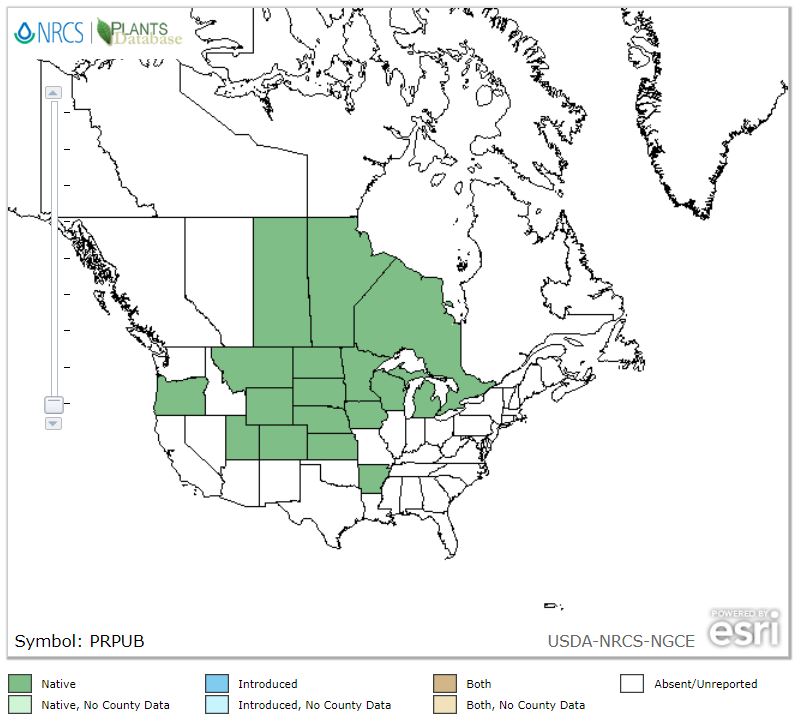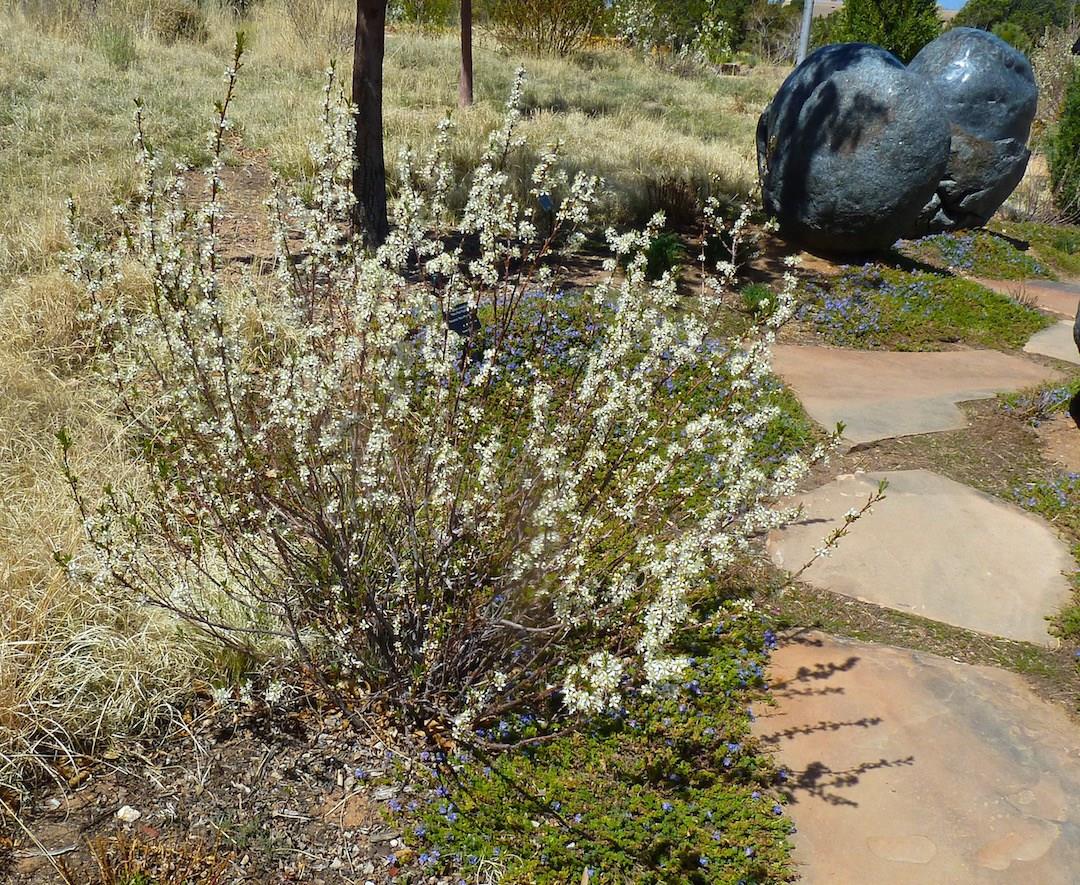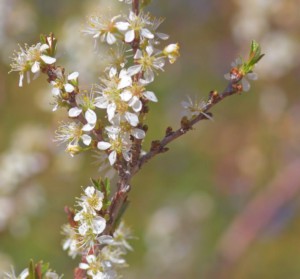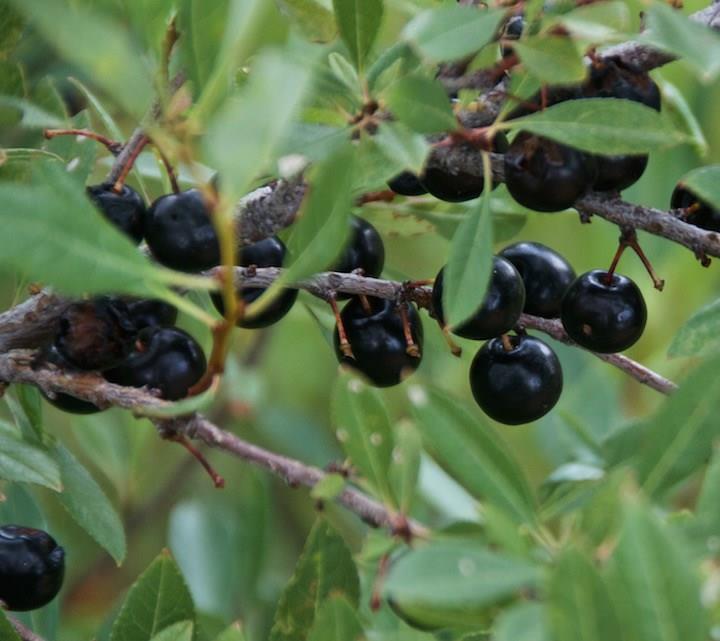Scientific name: Prunus pumila var. besseyi
Common name: western sand cherry
Family: Rosaceae (Rose Family)
Article by Susan Bruneni
The western sand cherry, Prunus pumila var. besseyi, is native to Central and Western United States, and Central and Western Canada. Western sand cherries grow wild from Canada to Colorado and although it is technically exotic, it adapts well to northern New Mexico gardens.


Western sand cherry shrub. Photo by Janice Tucker.
It is a low deciduous shrub, usually growing to four to six feet tall and four to seven feet wide on sandy hills, open plains, rocky slopes or shores, primarily in well-drained, sandy or sandy-loam soils. The western sand cherry is a hardy, drought-tolerant plant that needs full sun but doesn’t require much water. The western sand cherry has been widely transplanted or planted in gardens, orchards and acreages. Settlers often planted it around farmsteads as windbreaks.

Western sand cherry flowers. Photo by Janice Tucker.
In late spring, sand cherry branches are covered with white, half-inch flowers that are pollinated by insects. The three-quarter-inch fruits change from reddish to purplish and then black as they mature. The color indicates high anthocyanin levels, which suggest high antioxidant levels. There are now many cultivars available, with a wide range of flower and fall foliage colors.
Each fruit contains one fairly large seed or stone. They are dispersed by birds and animals and can readily sprout where dropped. They grow best in temperate climates, and their peak season is summer. The seeds of a western sand cherry do require some cold to germinate. Western sand cherry is short-lived, rarely reaching 20 years of age.
This plant was first identified and given a Latin name by botanist Charles Edwin Bessey (1845-1915). An older synonym for this species is Prunus besseyi. It was updated to the specific epithet “pumila” which means dwarf.

Western sand cherry fruit. Photo by Janice Tucker.
Native Americans consumed sand cherries ripe and fresh off the bush but also dried them for later use. Early settlers also discovered the flavor of the sand cherries and featured them in pies, jellies, jams, syrups and even wines. Sand cherry pie was a pioneer delicacy and is still a favorite dessert in the midwest. Settlers often waited for years until their orchards began to produce fruit, so they valued this native substitute. Sand cherries usually are dark purple to black in color. Ripe sand cherries are also consumed by many wildlife species (including deer).
Prunus species have been used to treat coughs and colds, as an antibiotic and in cancer research. A green dye can be obtained from the leaves. A dark grey to green dye can be obtained from the fruit. The plant can be used as a rootstock for plums.
(Note: toxins may be present in the seeds and leaves although normally in levels too low to be harmful and detectable by a bitter taste. However caution should be taken to eat only the fruit.)
References
“Prunus pumila”. Wikipedia. Wikimedia Foundation. 13 February 2019. Web. 30 April 2019. Retrieved from: https://en.wikipedia.org/wiki/Prunus_pumila.
“Prunus pumila var. besseyi”. Garden Explorer. Santa Fe Botanical Garden. Web. 30 April 2019. Retrieved from: https://santafebotanicalgarden.gardenexplorer.org/taxon-588.aspx
“Prunus pumila L. var. besseyi (L.H. Bailey) Gleason”. USDA, NRCS. 2019. The PLANTS Database (http://plants.usda.gov, 30 April 2019). National Plant Data Team, Greensboro, NC 27401-4901 USA.
“Western Sand Cherry, Prunus besseyi”. Natural Medicinal Herbs. Web. 30 April 2019. Retrieved from: http://www.naturalmedicinalherbs.net/herbs/p/prunus-besseyi=western-sand-cherry.php.


